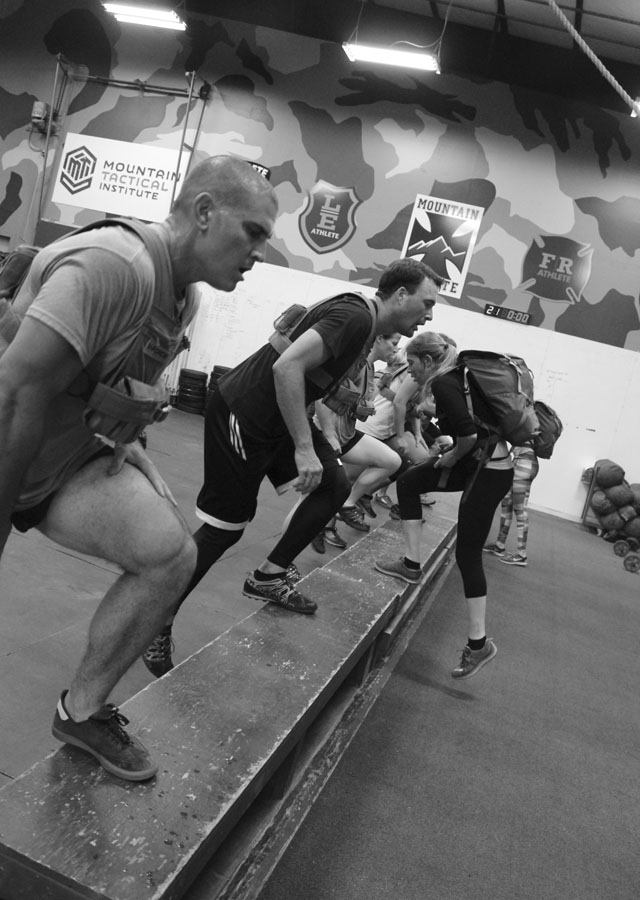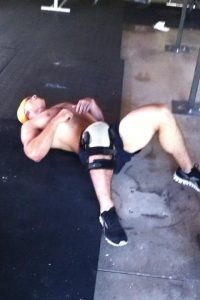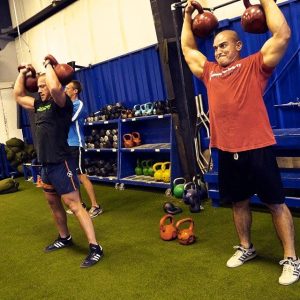
By Charles Bausman
I will never forget my first CrossFit workout.
It was 2008 and I was getting ready to attend USMC Officer Candidate School (OCS). I was an ex-linebacker who was still training like one in the weight room. At 5”11 and 235 lbs, I was a complete meathead who could Bench Press over 400lbs and Back Squat in the mid 500’s. A mile was the longest distance run I had ever attempted.
At the behest of my Marine recruiter – a steely-jawed Gunny, I went to the nearest CrossFit box to give it a shot. The introduction workout was “Cindy,” a 20-minute AMRAP of 5 Pull-ups, 10 Push-ups, and 15 Air Squats.
Easy Day.
The first five minutes went by without issue. By minute seven, I knew I was in trouble. By minute fifteen, my respiratory rate was out of control and my peripheral vision had narrowed to slits. It took thirty minutes after finishing the workout before I could move again. I’m fairly certain I threw up.

I was hooked and started to train there every day. My weight went down to 220lbs, although I still had a heavy emphasis on strength and power training. I thought I was making good progress on military-related conditioning. My Fran time was in the 2:20’s, I got my CrossFit coaching certification, and competed in the 2009 CrossFit Regionals as an individual… OCS would be no problem.
OCS came that summer. I quickly found that my CrossFit shape was not fitting the bill of the demands of the course. I was dying on long runs and rucks. The farthest I had run previously was three miles as required by the USMC PFT. I graduated but got my ass kicked. I knew that my current state of fitness would not meet requirements at follow-on training upon college graduation, especially at the notoriously challenging Infantry Officer Course.
After returning from OCS graduation, I told my coach about the experience. He recommended something called “Military Athlete.” It was still new and mostly unknown, but the focus on military field performance fitness seemed to be exactly what I needed.
I started with Operator Ugly. The lifts, bodyweight movements, and work capacity shuttles were no problem. The loaded run proved to be more challenging… I crossed the finish line with only seconds to spare according to the Pass/Fail criteria.
Just like after finishing “Cindy”, I was sold. Except this time, I had a specific direction for developing my fitness according to the requirements of the military.
Military Athlete was the first programming I did which emphasized things like periodization and progression. Most CrossFit gyms I’ve visited don’t do that (outside of athletes training for the CrossFit Games)… athletes with irregular attendance make it hard to implement a training program in a microcycle, let alone a mesocycle. The sport-specific structure of the Military Athlete programming just made more sense for me.
The individual training sessions demanded that I get out on the track, road, or trail and get some miles under my feet in running and rucking. It met my desire to lift heavy things (still emphasized in the programming) along with work capacity sessions which had greater variety in duration and form.
My weight has steadily gone down to a leaner and faster 200-205 lbs. I felt like a more well-rounded athlete when it came to follow on military training and during my time in an Infantry Battalion. I could ruck with the best of them, consistently ran a three mile run below twenty minutes, while still maintaining a strong base in strength and work capacity. As an individual with no military experience thrust into an immediate position of leadership, this fitness gave me some credibility in front of Marines recently returned from Afghanistan.
Fast forward to my own return from an Afghanistan deployment. The platoon had used Military Athlete to good effect and I wanted to learn more. I managed to get permission to attend the Military Athlete Advanced Programming Course and flew up to Jackson.

It was the first fitness certification course that focused on developing programming cycles, instead of teaching technique on the Squat, Clean, and Press (this was expected knowledge prior to attending). Rob and his staff emphasized the importance of event analysis like a Mt. Denali climb or attending a military school, in order to best develop a program to prepare the athlete. They emphasized that you can do this anywhere… a large segment of the course was dedicated to finding training solutions in austere environments.
Fast forward again to returning from another deployment, and my time on active duty was coming to an end. I threw a Hail Mary in the form of a resume to Rob at the now titled Mountain Tactical Institute (or was it SSD?… too many to keep track of). Rob brought me on as an intern shortly after my EAS, and I started to grind.
The position started as a general business and operations job, then morphed into a coach and researcher role. Rob brought me on as a full-time part of the staff, and the job has continued to evolve and be refined. I have been exceptionally fortunate to work here alongside the highest levels of mountain athletes and military personnel and see the positive effects of our strength and conditioning programming. It’s been a hell of a learning curve from that first CrossFit workout, but I’ve found that the MTI principles of training have been the best fit.
The Bottom Line
CrossFit is great as a way for individuals to push their fitness, be healthy, and be apart of a warm and welcoming community. Many of my best friends are those I met at that first CrossFit gym. It introduced me to a different way of training and I will always appreciate that. In terms of programming, the CrossFit website states “our specialty is not specializing.”
At Mountain Tactical Institute, we are in the business of specializing. Our training must meet the demands of our military, mountain, law enforcement, and fire/rescue athletes. That’s the difference that has allowed MTI to have an impact for those in professions where fitness equals survivability.
You Might Also Like CrossFit Is Awesome. How We’re Different.